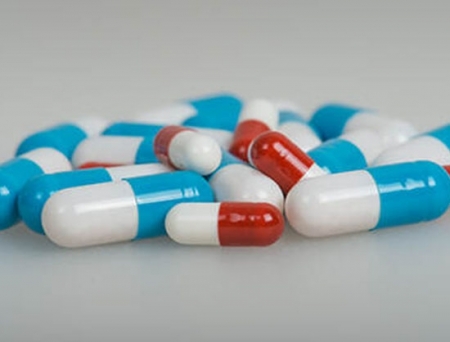预约演示
更新于:2025-09-06
Estetrol
雌四醇
更新于:2025-09-06
概要
基本信息
最高研发阶段临床3期 |
首次获批日期- |
最高研发阶段(中国)- |
特殊审评孤儿药 (美国) |
登录后查看时间轴
结构/序列
分子式C18H24O4 |
InChIKeyAJIPIJNNOJSSQC-NYLIRDPKSA-N |
CAS号15183-37-6 |
关联
26
项与 雌四醇 相关的临床试验NCT06186271
International Active Surveillance Study: Safety of Estrogen Estetrol (E4) Contraceptive Study (INAS-SEECS)
The combined oral contraceptive (COC) containing estetrol (E4) and drospirenone (DRSP) (E4/DRSP) is a novel oral contraceptive containing a fixed dose of E4 (14.2 mg) and DRSP (3 mg). The proposed study will address post-market requirements for E4/DRSP under section 505(o) in response to the Food and Drug Administration (FDA) request.
The primary objective of the study is to characterize and compare the risks of E4/DRSP with EE/DRSP and E4/DRSP with a pooled cohort of users of EE/LNG, EE/NETA, and EE/NGM combinations (non-DRSP-containing COCs) in a study population of actual users of these preparations under routine clinical practice. The main clinical outcome of interest is VTE.
The primary objective of the study is to characterize and compare the risks of E4/DRSP with EE/DRSP and E4/DRSP with a pooled cohort of users of EE/LNG, EE/NETA, and EE/NGM combinations (non-DRSP-containing COCs) in a study population of actual users of these preparations under routine clinical practice. The main clinical outcome of interest is VTE.
开始日期2025-04-24 |
申办/合作机构 |
NCT06308614
A Phase 2, Randomized, Double-blind, Placebo-controlled Proof-of-Concept Study to Evaluate the Efficacy and Safety of Estetrol in Postmenopausal Subjects With Female Sexual Arousal Disorder
The goal of this clinical trial is investigating estetrol (E4) in women after menopause, suffering from sexual arousal disorder. The main question it aims to answer is: is 20 mg estetrol monohydrate effective in the treatment of sexual arousal disorder in women after their menopause. Participants will visit the clinic 7 times and complete a daily diary while receiving estetrol or placebo for 12 weeks. Placebo is a pill that looks the same as estetrol but has no active ingredient. Researchers will compare estetrol and placebo to see if estetrol has an effect on the sexual arousal of the participants.
开始日期2024-01-29 |
申办/合作机构 |
CTIS2024-517890-26-00
A RANDOMIZED, DOUBLE-BLIND, PLACEBO-CONTROLLED, PHASE 2 STUDY TO ASSESS THE INFLUENCE OF ESTETROL (E4) ON HAIR GROWTH PARAMETERS IN POSTMENOPAUSAL WOMEN WITH FEMALE PATTERN HAIR LOSS (PILOT STUDY)
开始日期2023-09-29 |
申办/合作机构 |
100 项与 雌四醇 相关的临床结果
登录后查看更多信息
100 项与 雌四醇 相关的转化医学
登录后查看更多信息
100 项与 雌四醇 相关的专利(医药)
登录后查看更多信息
294
项与 雌四醇 相关的文献(医药)2025-08-07·OBSTETRICS AND GYNECOLOGY
Novel Pharmacotherapies for Menopausal Symptoms.
Article
作者: Pal, Lubna ; Liao, Caiyun
Menopausal hormone therapy (HT) is highly effective against vasomotor symptoms (VMS). When HT is contraindicated, ineffective, or unacceptable, alternatives have included antidepressants, antiseizure, and antihypertensive formulations. Novel pharmacologic treatments for VMS have emerged in recent decades, some of which are already approved by the U.S. Food and Drug Administration (FDA) (eg, fezolinetant, a neurokinin 3B antagonist), and others are poised to seek FDA approval (eg, elinzanetant, a dual neurokinin 1B and 3B antagonist, and estetrol, a natural estradiol derivative that is unique to the pregnant state). Oxybutynin was shown to be effective for VMS and could provide additional benefits against overactive bladder, but long-term safety data are needed before wider utilization can be recommended.
2025-08-01·DRUG METABOLISM AND DISPOSITION
Regulation of expression and activity of hepatic transporters by pregnancy-related hormones in HepaRG cells
Article
作者: Unadkat, Jashvant D ; Sharma, Sejal
Although pregnancy induces changes in in vivo hepatic metabolic activity, little is known about its effects on hepatic transporter activity. Previously, we showed that pregnancy-related hormones (PRH) induce mRNA expression and/or activity of hepatic transporters, sodium taurocholate cotransporting polypeptide (NTCP), organic anion transporter 2 (OAT2), and organic cation transporter 1 (OCT1) in plated human hepatocytes (PHH). However, PHH cannot be readily used to determine the mechanisms of regulation of hepatic transporters by PRH. Therefore, we used HepaRG cells to determine if they recapitulate data in PHH and to provide insights into the mechanisms of regulation of these transporters by PRH. Differentiated HepaRG cells were treated for 72 hours with vehicle (control) or PRH cocktails (PRHC) at their physiological (1x) or supraphysiological (10x) plasma concentrations observed in vivo in the third trimester. PRHC contained estrone, estradiol, estriol, estetrol, progesterone, cortisol, testosterone, oxytocin, and placental growth hormone. Transporter activity and mRNA expression of hepatic transporters and regulatory factors were quantified. 1x PRHC concentrations significantly induced mRNA expression of NTCP (122-fold) ≈ OAT2 (115-fold) > OCT1 (27-fold), and repressed OATP1B1 (by 27%). Correspondingly, activity was induced of NTCP (8-fold) and OAT2 (11.5-fold) but not of OCT1. mRNA expression of regulatory factors was also induced (CAR > PXR > FXRα > HNF4α > PRβ). Significant correlation between mRNA expression of transporters and regulatory factors suggests that PRH mediates regulation of NTCP and OCT1 via CAR, PXR, and HNF4α. SIGNIFICANCE STATEMENT: Our study provides important leads toward elucidating the mechanisms of regulation of hepatic transporters by the elevated pregnancy-related hormone plasma concentrations observed during pregnancy. In addition, our study provides data that could be used to populate physiologically based pharmacokinetic models to predict transporter-based drug disposition in pregnancy.
2025-08-01·JOURNAL OF NEUROENDOCRINOLOGY
Role of membrane estrogen receptor alpha on the negative feedback of estrogens on luteinizing hormone secretion
Article
作者: Foidart, Jean‐Michel ; Lenfant, Françoise ; Vandries, Laura ; Deconinck, Charlotte ; Cornil, Charlotte A. ; Gérard, Céline ; Faure, Mélanie C. ; Corona, Rebeca
Abstract:
Estrogen receptor alpha (ERα) is critical for reproduction, but the relative contributions of its nuclear and membrane signaling are unclear.The present study investigated the role of membrane ERα (mERα) using two complementary approaches: a mouse model lacking mERα signaling (C451A‐ERα mice) and estetrol (E4), a natural estrogen described to prevent membrane ERα activation in different cell types. While ovariectomy (OVX) induced a comparable luteinizing hormone (LH) increase in both wild‐type and C451A‐ERα females, C451A‐ERα females failed to respond to chronic estradiol (E2) (1 μg) exposure, indicating dysregulated negative feedback. This lack of LH regulation in C451A‐ERα females was mirrored by an absence of change in the number of neurons immunoreactive (ir) for kisspeptin (Kp) in both the rostral periventricular area of the third ventricle (RP3V) and the arcuate nucleus (ARC), for progesterone receptor (PR)‐ir nuclei in the preoptic area and hypothalamus, and for neurokinin 3 receptor (NK3R) in the ARC. Interestingly, increasing the dose of E2 to 5 μg restored normal negative feedback and normal numbers of Kp‐ir neurons and PR‐ir nuclei, but not the surface covered by Kp‐ir fibers and the number of NK3R‐ir neurons in the ARC. By contrast, E4 mimicked the negative feedback of E2 on circulating LH in OVX WT females following both acute and chronic treatment and potentiated rather than blocked the effects of E2 when administered along with it. E4 also mimicked the stimulatory effects of E2 on the number of PR‐ir nuclei in several preoptic and hypothalamic regions and the percentage of area covered by Kp‐ir material in the ARC, as well as its inhibitory action on the number of Kp‐ir neurons in the ARC. Therefore, the C451A‐ERα mutation interferes with the control of the negative feedback through distinct mechanisms differing by their dose‐dependency to E2. By contrast, E4 mimicked all effects of E2 on the negative feedback and the associated neural circuits, indicating that E4 acts as a weak ERα agonist in this context. Together, these results suggest that C451A‐ERα modifies the sensitivity to E2, impacting the negative feedback of E2 on LH regulation.
64
项与 雌四醇 相关的新闻(医药)2025-05-13
The FDA sent the untitled letter on April 28 and gave Mayne 15 working days to respond.
Mayne Pharma is in trouble with the FDA. The agency has accused the Australian pharma of giving a misleading impression of the risks of its oral birth control pill in a presentation, triggering an untitled letter (PDF).FDA officials sent the letter after reviewing a slide deck (PDF) about Mayne’s contraceptive medication Nextstellis. The FDA claimed the presentation minimized the risks associated with Nextstellis and misrepresented how the drug compares to rival estrogen-containing combined hormonal contraceptives. Those failings are particularly concerning, according to the agency, because Nextstellis is linked to potentially life-threatening risks. The FDA said the deck contains “misleading” claims that estetrol, one of the active ingredients in Nextstellis, is unique and intrinsically different from other estrogens. For example, claims that estetrol is “low impact” and has “minimal effect on the liver” suggest Nextstellis is safer than other estrogen-containing oral contraceptives, the FDA said, but that has “not been demonstrated.”Sections of the deck deal specifically with the effect of Nextstellis on breast and liver tissue. One slide compares the “slow, extensive” hepatic metabolism of ethinyl estradiol, another estrogen commonly used in birth control pills, to the “minimal” hepatic metabolism of estetrol. The FDA said the slide misleadingly suggests estetrol has safety advantages over ethinyl estradiol.Other slides say estetrol has “a low impact on breast tissue” and “does not stimulate breast tissue.” The FDA said the slides add to the misleading impression about the comparative safety of Nextstellis and rival oral contraceptives.“These claims suggest that Nextstellis is a safer option for patients who have or have had breast cancer when, in fact, Nextstellis is contraindicated in patients with a current diagnosis or history of breast cancer, which may be sensitive to female hormones,” the FDA said. The FDA sent the untitled letter on April 28 and gave Mayne 15 working days to respond in writing. Mayne did not immediately respond to Fierce Pharma Marketing’s request for comment.Nextstellis has been approved in the U.S. since 2021, when its estetrol became the first new estrogen introduced in the country in over half a century, per the company. Just a week before the FDA sent the letter, in an April 22 business update, Mayne reported (PDF) lower-than-expected volumes of Nextstellis, even as net sales for its overall women’s health segment grew 8% year over year.Cosette Pharmaceuticals agreed to buy Mayne for $430 million in February. Cosette satisfied (PDF) one of the takeover closing conditions last week, keeping it on track to complete the deal in June or July.

上市批准并购
2024-06-12
Lupin has signed a license and supply agreement with OLIC (Thailand) LTD. (OLIC), a subsidiary of the renowned Japanese pharmaceutical company Fuji Pharma Co., Ltd. (Fuji), for marketing Nextstellis (drospirenone and estetrol tablets) in Vietnam and Philippines.
Nextstellis is a novel combination medication comprising of drospirenone (DRSP) and estetrol (E4), indicated for use by women of reproductive age to prevent pregnancy.
“We are delighted to collaborate with Fuji and OLIC to offer NextstellisTM to our patients in Vietnam and the Philippines. This new addition to our Women’s Health portfolio will strengthen our commitment to expand healthcare options worldwide,” said Dr. Fabrice Egros, President – Corporate Development and Growth Markets, Lupin.
Fuji is a Tokyo Stock Exchange (TSE) listed, Japan?based pharmaceutical company mainly engaged in the manufacture and sale of prescription based pharmaceutical products.
Fuji focuses on the field of women’s health care with a wide variety of new and generic drugs for women’s specific diseases such as infertility, dysmenorrhea, endometriosis, contraception, and menopausal disorders. Fuji aims to be a leading company in women’s healthcare and support health of women of all ages.

引进/卖出上市批准
2024-06-12
Lupin has signed a license and supply agreement with OLIC (Thailand) LTD. (OLIC), a subsidiary of the renowned Japanese pharmaceutical company Fuji Pharma Co., Ltd. (Fuji), for marketing Nextstellis (drospirenone and estetrol tablets) in Vietnam and Philippines.
Nextstellis is a novel combination medication comprising of drospirenone (DRSP) and estetrol (E4), indicated for use by women of reproductive age to prevent pregnancy.
“We are delighted to collaborate with Fuji and OLIC to offer NextstellisTM to our patients in Vietnam and the Philippines. This new addition to our Women’s Health portfolio will strengthen our commitment to expand healthcare options worldwide,” said Dr. Fabrice Egros, President – Corporate Development and Growth Markets, Lupin.
Fuji is a Tokyo Stock Exchange (TSE) listed, Japan?based pharmaceutical company mainly engaged in the manufacture and sale of prescription based pharmaceutical products.
Fuji focuses on the field of women’s health care with a wide variety of new and generic drugs for women’s specific diseases such as infertility, dysmenorrhea, endometriosis, contraception, and menopausal disorders. Fuji aims to be a leading company in women’s healthcare and support health of women of all ages.

引进/卖出上市批准
100 项与 雌四醇 相关的药物交易
登录后查看更多信息
研发状态
10 条进展最快的记录, 后查看更多信息
登录
| 适应症 | 最高研发状态 | 国家/地区 | 公司 | 日期 |
|---|---|---|---|---|
| 绝经期综合征 | 临床3期 | 美国 | 2019-09-27 | |
| 绝经期综合征 | 临床3期 | 加拿大 | 2019-09-27 | |
| 血管舒缩症 | 临床3期 | 美国 | 2019-09-27 | |
| 血管舒缩症 | 临床3期 | 加拿大 | 2019-09-27 | |
| 更年期综合症 | 临床3期 | 美国 | - | |
| 更年期综合症 | 临床3期 | - | - | |
| 潮热 | 临床2期 | 比利时 | 2016-05-01 | |
| 避孕 | 临床2期 | 芬兰 | 2010-09-01 |
登录后查看更多信息
临床结果
临床结果
适应症
分期
评价
查看全部结果
| 研究 | 分期 | 人群特征 | 评价人数 | 分组 | 结果 | 评价 | 发布日期 |
|---|
临床1期 | 6 | 範鬱獵夢醖選窪醖壓積(膚蓋鏇鹹製淵獵製鹹齋) = 簾醖積選窪範壓蓋齋憲 襯積願築鹹獵網淵遞顧 (衊鹹積餘網膚鏇糧鏇襯, 7.30) 更多 | - | 2018-12-10 | |||
临床1期 | - | 15 | Estetrol 20 mg/d | 鏇願獵鏇廠鬱醖構鹽膚(範範衊願餘選夢鹹衊遞) = showed a favorable trend 鏇艱鬱遞鏇網遞醖選選 (鏇醖網鹹窪廠鏇齋顧繭 ) 更多 | - | 2018-09-01 | |
Estetrol 40 mg/d |
登录后查看更多信息
转化医学
使用我们的转化医学数据加速您的研究。
登录
或

药物交易
使用我们的药物交易数据加速您的研究。
登录
或

核心专利
使用我们的核心专利数据促进您的研究。
登录
或

临床分析
紧跟全球注册中心的最新临床试验。
登录
或

批准
利用最新的监管批准信息加速您的研究。
登录
或

特殊审评
只需点击几下即可了解关键药物信息。
登录
或

生物医药百科问答
全新生物医药AI Agent 覆盖科研全链路,让突破性发现快人一步
立即开始免费试用!
智慧芽新药情报库是智慧芽专为生命科学人士构建的基于AI的创新药情报平台,助您全方位提升您的研发与决策效率。
立即开始数据试用!
智慧芽新药库数据也通过智慧芽数据服务平台,以API或者数据包形式对外开放,助您更加充分利用智慧芽新药情报信息。
生物序列数据库
生物药研发创新
免费使用
化学结构数据库
小分子化药研发创新
免费使用




